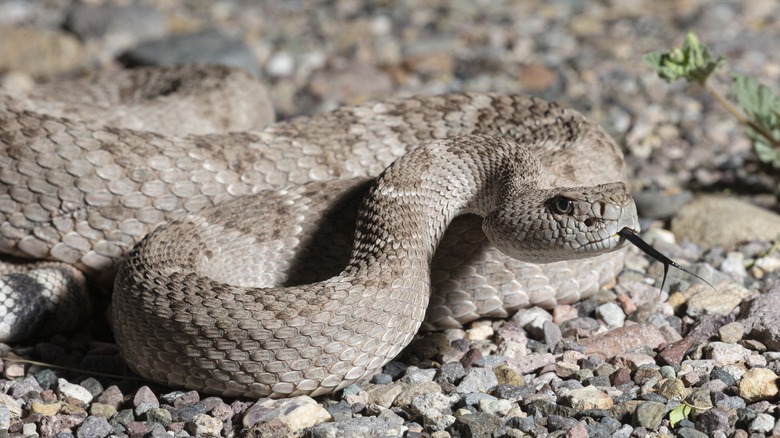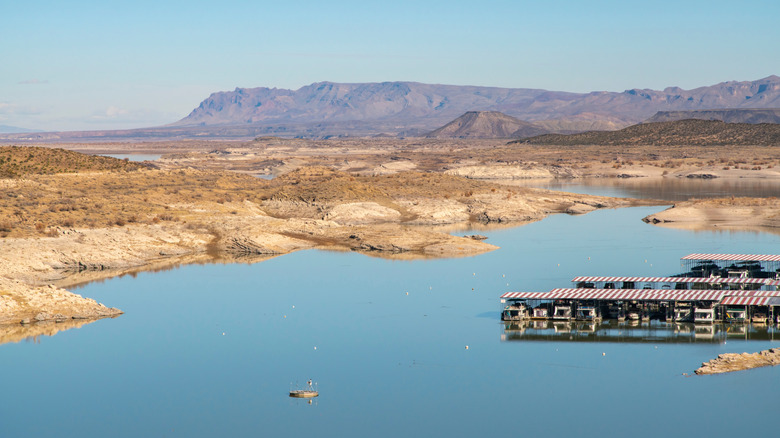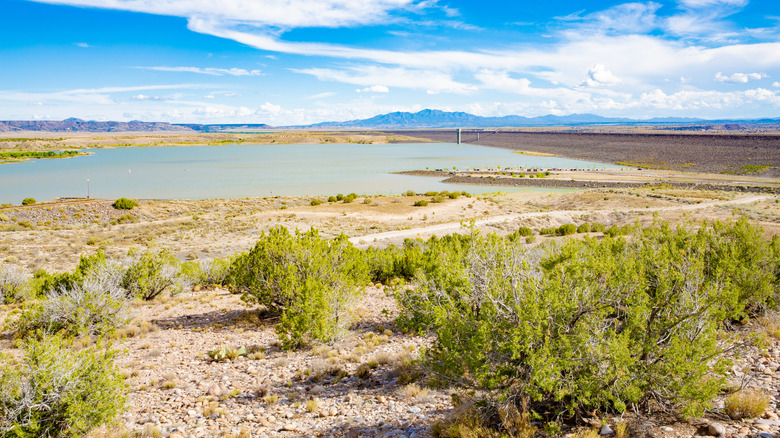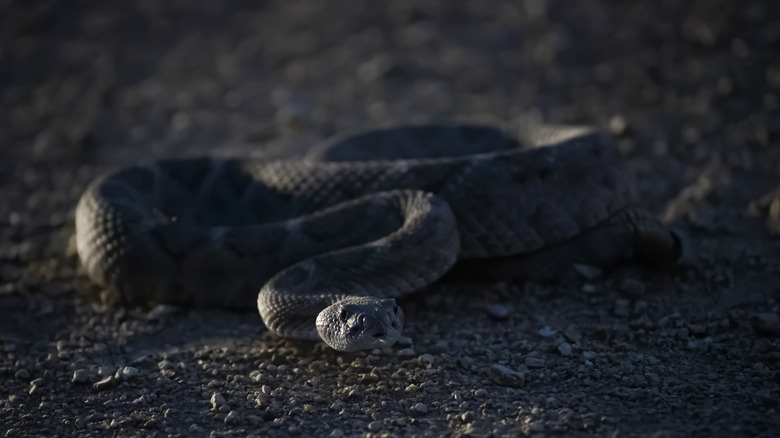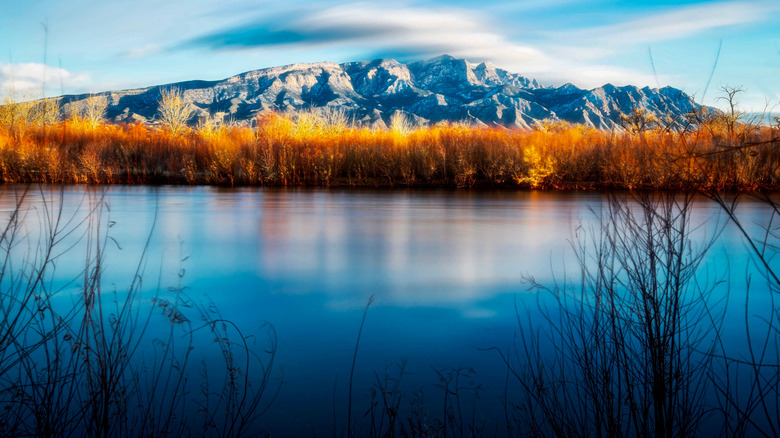New Mexico's Most Snake-Filled Bodies Of Water To Reconsider Swimming In
New Mexico, otherwise known as the Land of Enchantment, draws crowds from all over to its dramatic desert canyons, charming mountain resorts, and outdoor marvels like the spectacular White Sands National Park. With endless rugged trails and watery oases in its vast and varied landscape, New Mexico is one of the most enchanting states in the Southwest. But beneath its spellbinding façade, some of the state's most beautiful lakes and rivers are actually home to venomous snakes. Though sometimes harmless, encountering snakes while fishing, boating, or hiking can still be unnerving, so it's good to be prepared to meet these critters while out in the wild.
These slithering residents usually play a vital ecological role in the local environment by controlling rodents and contributing to the area's biodiversity. Though venomous rattlesnakes may scare you, by staying alert to threats, you can safely enjoy New Mexico's spectacular waterside scenery. Most snakes you encounter will be harmless, and respect comes first and foremost because while you may be a tourist in these parts, the lakes are the permanent homes of these beautiful animals.
Rio Grande
A river that snakes from Colorado to New Mexico, the staggering 1,800-mile-long Rio Grande is bordered by lush woodlands and a million-plus-year-old cottonwood forest that brims with wildlife. This serpentine-like river is home to a diversity of snakes, over 30 known species, including the western diamondback rattlesnake, which has a nasty, potentially deadly bite.
The venomous western diamondback is considered dangerous — it's large, defensive, and supposedly quick to strike when disturbed. The coral snake is more likely to flee than fight, and breakthroughs are rare. There are also a number of non-venomous residents in the area, including the bullsnake, the great plains rat snake, the Gulf Coast ribbon snake, and the Texas blind snake. Note that bullsnakes still bite if threatened; when traveling along the banks of this river, make sure to wear appropriate footwear and long pants.
Elephant Butte Lake
New Mexico's largest reservoir is the enormous Elephant Butte Lake, an expansive body of water spanning 36,000 acres that draws campers, boaters, and hikers to its shores. The warm water is teeming with animal life, making this a playground for predators, amongst them the Mojave rattlesnake and the prairie rattlesnake. Be alert for the sound of rattling as a warning, and note that many of these snakes are also aquatic. Hikers are advised to use a stick to navigate paths and clear bushes and out-of-reach places where venomous snakes may be present.
Wildlife enthusiasts will also be happy to know there are plenty of non-venomous black-necked garter snakes, striped whipsnakes, and glossy snakes on the shores of Elephant Butte. Note that there is no designated swimming area, and people are warned to swim at their own risk. Fishing is allowed on the lake, except at the marinas and boat docks. Anglers will also be pleased by the populations of striped bass and bluegill in the water.
Cochiti Lake
Another scenic beauty is Cochiti Lake, which lies along the Jemez foothills. The lake was created in 1975 with the foundation of the Cochiti Dam and is set within 50,000 acres of reservation lands. Its recreational areas include beaches and hiking trails, which are surrounded by grasslands that are ideal snake habitats. This is another grazing ground for the venomous western diamondback rattlesnake.
You'll also find non-venomous snakes here, with coachwhips and garter snakes often being mistaken for rattlesnakes but posing no real harm. You are advised to stay on marked trails and avoid venturing into the tall grass without proper footwear. Keep a flashlight handy if you're out at dawn or dusk, as snakes are more active during these times. If you're traveling with children, it's important to keep an eye on them at all times and emphasize the importance of staying away from snakes.
Conchas Lake
Near Tucumcari, Conchas Lake State Park features a golf course and a multitude of campsites. This is a popular spot for fishing, boating, and weekend vacations. The area has a semi-arid climate, which is conducive to many snake species, and you'll find prairie rattlesnakes hunting shoreline rodents along the waterfront. Non-venomous snakes, such as the gopher snake and coachwhip, are also found here. Although harmless, they can be intimidating!
When camping near the lake, make sure to scour the area before setting up your tent. Keep your tent sealed and campsite clean. Store firewood off the ground to reduce the hiding places for snakes. If you encounter one, make sure to give it space to slither away — snakes are usually just as afraid of you as you are of them!
Sandia Lake
North of Albuquerque, the three Sandia Lakes are also nestled in the Rio Grande Bosque. These serene lakes are a popular fishing destination surrounded by cottonwood trees and wetlands. It's no surprise that these lush conditions provide healthy breeding grounds for snakes. Here, you'll find "friendly" (non-venomous) Mexico garter snakes, long-nosed snakes, and striped whipsnakes minding their business among the foliage. However, rattlesnakes are known to inhabit the area, and due to the lake's proximity to urban areas, these snakes may be more well accustomed to human activity, so be wary.
Avoid reaching into bushes, and keep your eyes out near rocks. Pets should be kept on a leash. Of course, when visiting any of these lakes, it's highly recommended to carry a snakebite first aid kit and be aware of the nearest medical facility. In the unlikely case you are bitten, stay calm, let the snake escape to prevent being bitten again, keep the limb lower than the heart, and seek medical help immediately. Always travel with a phone.
Adhere to these simple measures and be mindful of the terrain around you to show respect to the beautiful reptiles that inhabit the land. For more adventure, head to this New Mexico site that's an open book of human history. It is one of the United States' most visually compelling natural wonders and is more than worth the trip.
